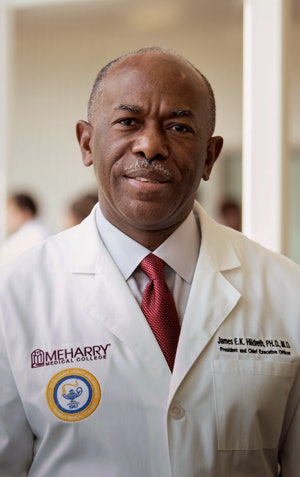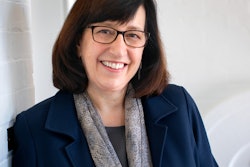Dr. James E.K. Hildreth has been president of Meharry Medical College, the nation’s oldest and largest historically Black academic health science center in Nashville, Tennessee, since July 2015, but for more than 40 years, the infectious disease expert has investigated viruses.
“The first virus I studied as a graduate student was flu, so, I know a lot about influenza,” says Hildreth whose work on “another pandemic virus, HIV,” has spanned a career.
 Dr. James E.K. Hildreth
Dr. James E.K. HildrethNow, as SARS-CoV-2, the specific coronavirus strain that causes COVID-19, fuels a new pandemic, Hildreth, the characteristically low-key scientist and CEO, has become a leader in the rapidly evolving response to the outbreak.
On Nashville’s new COVID-19 Task Force, Hildreth delivers frank media messages and public conversations about the science of the virus and its transmission. He also works with city and health officials to gauge how the novel coronavirus is impacting Nashville. As cases climb, he’s helping his city to prepare for its punch.
But Hildreth says the familiar roles he and others in the Meharry community have played, over the years, as watchmen, advocates and caretakers for the health of African Americans in the city and across the nation, have become more urgent since the emergence of COVID-19. They knew that compared to other groups, COVID-19 could be a burden or deadly for African Americans with pre-existing, chronic health conditions. That’s why Hildreth pushed to locate a free, drive-up COVID-19 testing center on his campus in Nashville’s largely Black Northside. In recent weeks, emerging reports have exposed the depth of racial health disparities and other vulnerabilities that exist across the U.S.
Meharry Medical College is not unlike most colleges and universities where campus life and learning have been upended by the virus. Still, Hildreth says he is not only determined to get his future physicians to the finish line, he wants to make sure that those in their last year “walk” in May.
In our conversation with Hildreth, he discusses COVID-19, from the nation’s response, to the need for a “new normal,” to HBCUs and, of course, the science behind the novel coronavirus.
This interview has been edited for length and clarity.
Prompted by COVID-19 to adapt his campus, clinics and commencement:
HILDRETH: We’ve had to adapt, like other institutions, by putting our courses online. All of our didactic courses are also online. With so many faculty and staff needing to work remotely, we had to do some technological upgrades to make that happen. Our clinics are also working on reduced hours, and we’ve converted some of our in-patient visits to telemedicine visits.
On the dental school side, it’s been a total shutdown of clinical activities. Most of the procedures that dentists do use instruments that produce aerosols. We know with certainty that aerosols are one of the ways that this coronavirus is transmitted. It’s not just [Meharry], all 65 dental schools in the U.S. are in the same position, having to discontinue all activities related to training students. The biggest challenge, right now, is making sure our dental students get the required clinical competencies they need, since all activities had to be shut down. Like other dental schools, we are using mannequins. They are pretty realistic, but they aren’t the real thing. But for now, the students can keep practicing and improving their skills.
One of the biggest disappointments for me was that we had to cancel Match Day. It’s the day that students find out where they are going for their residency. We had a terrific outcome this year: 93% or 95% of the students matched. They are going to some of the best programs in the country. But clearly, we could not have an in-person gathering with hundreds of people in a room. So, we did it virtually.
But we’re not going to cancel commencement, we just have to do it in a different way. It will probably be virtual for the families, and some kind of in-person celebration for the students in small groups. We are hoping that it can be before the fourth-year students leave campus. They had to be brought back from their clinical rotations, mainly to preserve PPE (personal protective equipment) for the fight against COVID-19. We want to do something for the students with myself, the dean and maybe one other person, using social distancing. It [commencement] can be broadcast or livestreamed. We have to have some way to celebrate their success.
The impact of a slow-moving national response to a fast-moving public health crisis:
HILDRETH: I think the first case (of COVID-19) to reach the United States was on January 21 or so. It was a young Chinese man who had traveled from Wuhan [China] to the United States. Shortly after, there was an outbreak in Washington State. We needed, then, to have a focus on this at the national level. We had an opportunity in early January to really take steps to slow this thing down, but unfortunately, that opportunity was missed.
In a country that has almost 3 million travelers on 44,000 flights a day, you can see how easily this virus can spread quickly, from just a few individuals. We started with one case in January, and in the span of weeks, we were in the thousands. That’s because viruses have a basic reproduction number. It relates to the average number of people who will potentially be infected by someone who carries a virus and is contagious. And for this novel coronavirus, that number is four. If you do the math or the modeling, it means there is the potential to double that number every six days. In New York, it has been doubling even faster than that.
Again, knowing what was happening with the virus in China, and if we had taken steps earlier, at the national level, things may have looked different, now.
Some things we know about COVID-19 and what is still being unraveled:
HILDRETH: People who are asymptomatic can clearly transmit the virus to others. We don’t know exactly how it happens, but the evidence is quite compelling. In the most likely scenario, the virus is being aerosolized. In other words, when people who have the virus replicating in their lungs exhale, the virus can be present in expired air. Whenever we breath out, the air is moisturized and always has some level of vapor in it. Those vapors can be in the form of small droplets that linger in the air for a period of time.
We also don’t know if someone, who has been infected and has cleared the virus, can be re-infected. And, if they are re-infected, what is the timeline for it?
There is also the possibility that this virus may turn into a seasonal challenge for us. Many viruses that cause seasonal common colds are close cousins to this novel coronavirus and are also in the coronavirus family. The reality is, as we take steps to mitigate COVID-19 through social distancing and other measures, it’s possible that as soon as we take our foot off the gas pedal, and ease up on these prevention measures, a few individuals who have gone undiagnosed could transmit the virus to those who are uninfected. We could then find ourselves back where we started.
That’s why there is an intense effort to accelerate the production of a vaccine and to find a drug to treat infected individuals. But absent a vaccine and an effective drug, there is every possibility that we will need to go through repeated cycles of social distancing. How long these cycles will be, no one can really say.
I agree with Dr. [Anthony] Fauci and others who have concluded that the soonest we can have this thing behind us is early summer. Then, I think there has to be a new normal. Just keep in mind, viruses don’t respect county, city, state or continental boundaries. We may do really well as a country, but unless we are willing to put travel restrictions on people from certain countries, the global population will be going through this all over again. That’s why a concerted, cohesive national strategy is necessary.
HBCU leaders have an important role to play during the COVID-19 pandemic:
HILDRETH: One of the most important roles for HBCUs during this outbreak is to continue to serve as trusted messengers and opinion leaders for these communities. A lot of people are not trusting what they are hearing from national leaders. I guess that’s not surprising. The leadership at HBCUs needs to be as well-informed as possible so that they can keep people informed and provide them with truthful information about this virus, how it spreads and how they can protect themselves. That’s really important.
That’s why I try my best to speak about the science, but in a way that shows people that there is an end to this and that we all have a part to play in stopping the spread of COVID-19. You’re right, there are a lot of vulnerable populations in the communities and in the neighborhoods that surround our campuses. We know for sure that pre-existing conditions dramatically increase the chances of severe diseases like asthma, diabetes and heart disease. We also believe that obesity can be a factor in the severity of COVID-19 infection because obesity compromises lung function. So, because African Americans tend to have those kind of chronic diseases and conditions at a disproportionately higher rate than other populations, it’s even more important that, as African Americans, we take precautions to protect ourselves. That’s been my message to those in our community.
This article originally appeared in the April 30, 2020 edition of Diverse. You can find it here.















